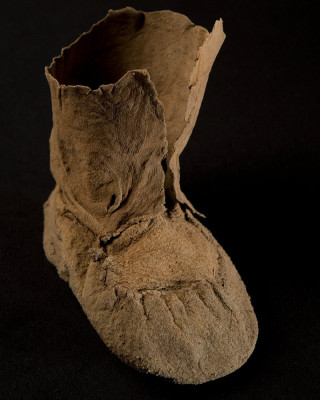Explorer Corps Marker: Box Elder County
Find the Marker
The Box Elder County marker is in the grass on the southeast side of the Historic Box Elder Courthouse at 1 South Main Street in Brigham City.
41°30’37.6884”N 112°0’53.838”W
Dig Deeper

Long ago, during the last Ice Age, the waters of ancient Lake Bonneville carved great divots into the limestone along its northern expanse. In time, as Lake Bonneville shrunk and became the Great Salt Lake, those holes in the stone became habitable caverns – home to Native Americans with an unexpected connection to the far north. These are the Promontory Caves.
The archaeological significance of the Promontory Caves wasn’t understood until about a century ago. In 1930, University of Utah archaeologist Julian Steward began to explore these limestone caves and the traces of ancient culture within. His approach was more methodical than some of his predecessors. Previous generations of archaeologists would often dig indiscriminately in the search for artifacts. What Steward was after, by contrast, was a more detailed picture that included how items related to each other in space and through the cave layers.
The archaeologists found a great deal within the cave layers. The careful excavation turned up animal bones, the bark and chaff of plants, soil samples, charcoal from firepits, stone tools, fiber mats, baskets, and more. But there was one type of item that was most intriguing of all to Steward.
Among the items Steward and colleagues found in the caves were moccasins. Only, as Steward soon realized, the moccasins weren’t like any others found in the region before. In fact, it seemed that the moccasins from Promontory Caves mostly closely resembled those made by peoples who lived between the Pacific Northwest and the Arctic. The people who lived in Promontory Caves long ago belonged to a different cultural group than others known at the time, their carefully-crafted footwear being a crucial clue to the connection.
The moccasins are now curated in the collections of the Natural History Museum of Utah, and they’re a frequent draw for archaeologists and anthropologists. But many fascinating mysteries remain unresolved… How the moccasins came to be preserved so well in the caves? How did the makers of the Promontory moccasins relate to the Fremont people who lived in the area at the same time? Did these groups pf people interact?
Trying to understand what the moccasins and other artifacts might tell us requires a different mindset. While the area around Promontory Caves is dry and seemingly harsh today, back during the time people lived there the surrounding area was much more marshy and green. There must have been something about the cave that made it such a good place to live on the landscape, and there must have been a reason that people eventually moved on. But the fact that people dwelled in the cave preserved a record of their presence, a thread that leads back to a very different, more ancient time.
Want to Go Farther?
The cave, on the shore of Utah’s Great Salt Lake, was first excavated in the early 1930s. The Promontory Caves are closed to the public to help protect this precious site. You can visit the Natural History Museum of Utah to see some of the Promontory Caves moccasins on display.